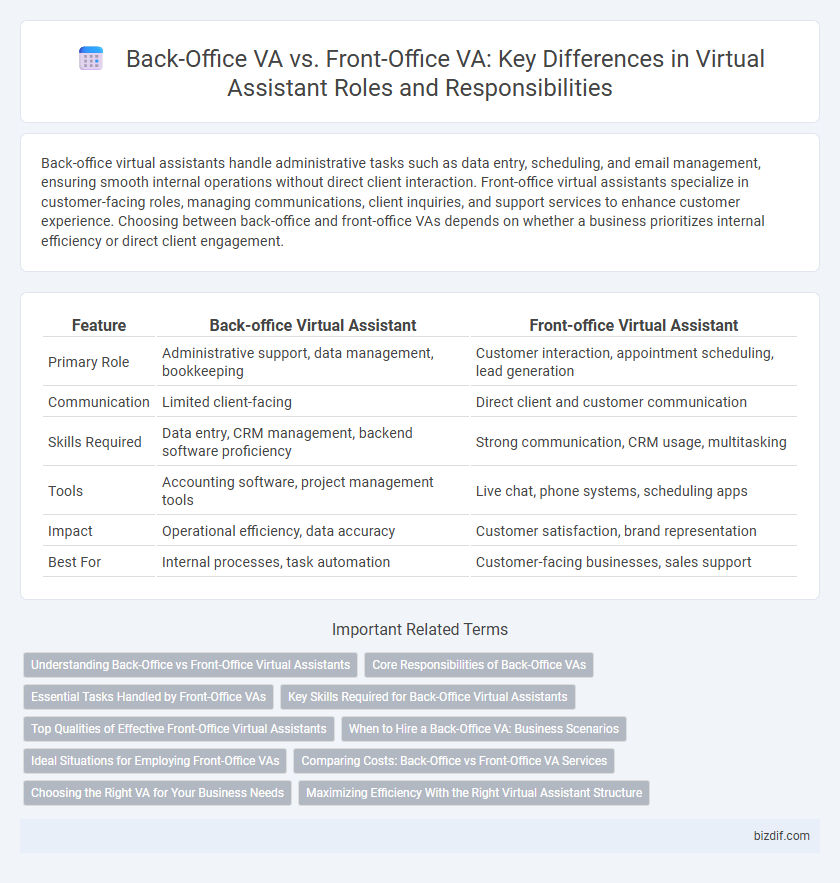Back-office virtual assistants handle administrative tasks such as data entry, scheduling, and email management, ensuring smooth internal operations without direct client interaction. Front-office virtual assistants specialize in customer-facing roles, managing communications, client inquiries, and support services to enhance customer experience. Choosing between back-office and front-office VAs depends on whether a business prioritizes internal efficiency or direct client engagement.
Table of Comparison
| Feature | Back-office Virtual Assistant | Front-office Virtual Assistant |
|---|---|---|
| Primary Role | Administrative support, data management, bookkeeping | Customer interaction, appointment scheduling, lead generation |
| Communication | Limited client-facing | Direct client and customer communication |
| Skills Required | Data entry, CRM management, backend software proficiency | Strong communication, CRM usage, multitasking |
| Tools | Accounting software, project management tools | Live chat, phone systems, scheduling apps |
| Impact | Operational efficiency, data accuracy | Customer satisfaction, brand representation |
| Best For | Internal processes, task automation | Customer-facing businesses, sales support |
Understanding Back-Office vs Front-Office Virtual Assistants
Back-office virtual assistants handle administrative tasks such as data entry, bookkeeping, and scheduling, ensuring operational efficiency behind the scenes. Front-office virtual assistants focus on customer-facing duties like managing emails, phone calls, and social media interactions, enhancing client engagement and support. Understanding these distinctions helps businesses allocate resources effectively and optimize workflow management.
Core Responsibilities of Back-Office VAs
Back-office virtual assistants handle essential administrative tasks such as data entry, document management, and bookkeeping to support smooth business operations behind the scenes. They focus on maintaining accurate records, managing email correspondence, and processing invoices, allowing front-office teams to engage directly with clients. Their role is crucial for ensuring operational efficiency, data organization, and compliance with company policies.
Essential Tasks Handled by Front-Office VAs
Front-office virtual assistants manage essential tasks including scheduling appointments, handling customer inquiries, and managing email correspondence to ensure smooth client interactions. They often represent the company's first point of contact, providing real-time support via phone, chat, or video calls. By efficiently coordinating front-office operations, these VAs enhance customer satisfaction and streamline communication workflows.
Key Skills Required for Back-Office Virtual Assistants
Back-office virtual assistants require strong organizational skills, proficiency in data management software, and expertise in handling administrative tasks such as invoicing, record keeping, and customer database updates. Technical skills including knowledge of Excel, CRM systems, and cloud-based collaboration tools are essential for efficient task execution. Attention to detail, confidentiality, and time management are critical to maintaining smooth operational workflows behind the scenes.
Top Qualities of Effective Front-Office Virtual Assistants
Effective front-office virtual assistants excel in strong communication skills, multitasking capabilities, and a customer-centric approach that enhances client interactions. Proficiency in managing scheduling, handling inquiries, and maintaining a professional virtual presence ensures seamless front-desk operations. Adaptability to diverse client needs and a high level of emotional intelligence further distinguish top-performing front-office virtual assistants.
When to Hire a Back-Office VA: Business Scenarios
Hiring a back-office virtual assistant is ideal during periods of rapid business growth when administrative tasks such as data entry, invoice processing, and inventory management consume excessive time. Small to medium-sized enterprises experiencing scaling challenges benefit from delegating these operational duties to maintain efficiency and focus on core activities. Businesses with seasonal workload spikes also find back-office VAs essential for managing fluctuating demands without long-term staffing commitments.
Ideal Situations for Employing Front-Office VAs
Front-office virtual assistants excel in client-facing roles such as managing customer inquiries, scheduling appointments, and handling live chat support, making them ideal for businesses seeking to enhance customer interaction and responsiveness. They are particularly valuable for startups and small businesses aiming to maintain a professional client communication channel without investing in full-time staff. Employing front-office VAs is optimal in scenarios requiring real-time engagement and personalized customer experiences to boost satisfaction and retention.
Comparing Costs: Back-Office vs Front-Office VA Services
Back-office virtual assistants typically incur lower costs due to their focus on administrative and operational tasks that require less direct client interaction, enabling businesses to optimize budget allocation. Front-office virtual assistants command higher fees reflecting their responsibilities in customer engagement, sales support, and real-time communication that directly impact client satisfaction and revenue generation. Companies can reduce operational expenses by leveraging back-office VAs for data entry, scheduling, and bookkeeping, while front-office VAs justify their premium through enhanced customer experiences and immediate problem resolution.
Choosing the Right VA for Your Business Needs
Back-office virtual assistants specialize in administrative tasks like data entry, bookkeeping, and email management, optimizing internal operations for efficiency and accuracy. Front-office virtual assistants handle customer-facing roles such as appointment scheduling, client communication, and social media interaction, enhancing customer experience and engagement. Selecting the right VA depends on your business priorities: streamline internal processes with a back-office VA or improve client relations and brand presence with a front-office VA.
Maximizing Efficiency With the Right Virtual Assistant Structure
Back-office virtual assistants specialize in administrative tasks such as data entry, invoicing, and record management, enhancing operational efficiency by streamlining internal processes. Front-office virtual assistants focus on client interactions, including customer service, appointment scheduling, and lead generation, ensuring positive engagements and business growth. Aligning the right mix of back-office and front-office VA roles maximizes productivity and optimizes resource allocation within any organization.
Back-office VA vs Front-office VA Infographic

 bizdif.com
bizdif.com